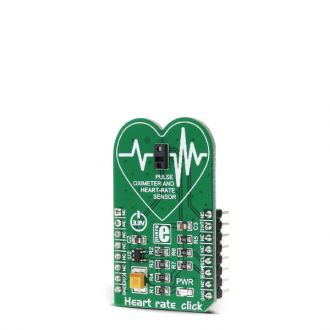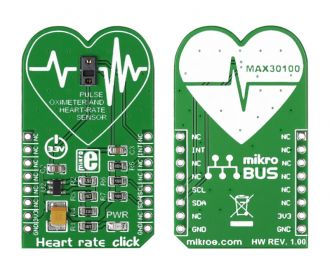
We strongly encourage users to use Package manager for sharing their code on Libstock website, because it boosts your efficiency and leaves the end user with no room for error. [more info]

Rating:
Author: MIKROE
Last Updated: 2018-03-12
Package Version: 1.0.0.1
mikroSDK Library: 1.0.0.0
Category: Biometrics
Downloaded: 9781 times
Followed by: 3 users
License: MIT license
Heart Rate click carries a MAX30100 integrated pulse oximetry and heart-rate sensor. It’s an optical sensor that derives its readings from emitting two wavelengths of light from two LEDs, then measuring the absorbance of pulsing blood through a photodetector. Uses 3.3V power supply.
Do you want to subscribe in order to receive notifications regarding "Heart rate click" changes.
Do you want to unsubscribe in order to stop receiving notifications regarding "Heart rate click" changes.
Do you want to report abuse regarding "Heart rate click".


Front and back side appearance of the Heart Rate click board.
View full imageLibrary Description Key functions:
Examples Description
void applicationTask()
{
if (heartrateDataReady())
{
sample_num = heartrate_readIrRed( &ir_buff, &red_buff );
if ( sample_num >= 1 )
{
ir_average = 0;
red_average = 0;
for ( counter1 = 0; counter1 < sample_num; counter1++ )
{
ir_average += ir_buff[counter1];
red_average += red_buff[counter1];
}
ir_average /= sample_num;
red_average /= sample_num;
counter2++;
if(counter2 > 100)
{
mikrobus_logWrite("Average value of Red LED sensor per 100 samples:",
_LOG_TEXT);
WordToStr(red_average, text);
mikrobus_logWrite(text,_LOG_LINE);
mikrobus_logWrite("Average value of IR LED sensor per 100 samples:",
_LOG_TEXT);
WordToStr(ir_average, text);
mikrobus_logWrite(text,_LOG_LINE);
counter2 = 0;
}
}
}
}
Other mikroE Libraries used in the example:
Additional notes and information Depending on the development board you are using, you may need USB UART click, USB UART 2 click or RS232 click to connect to your PC, for development systems with no UART to USB interface available on the board. The terminal available in all MikroElektronika compilers, or any other terminal application of your choice, can be used to read the message.